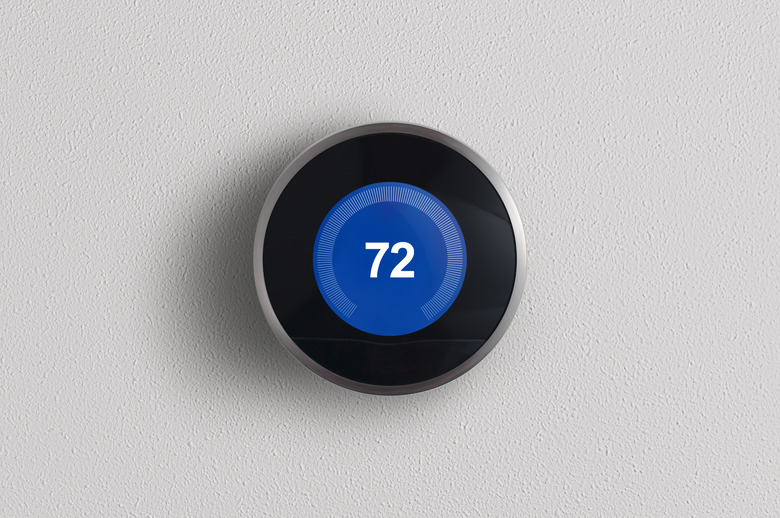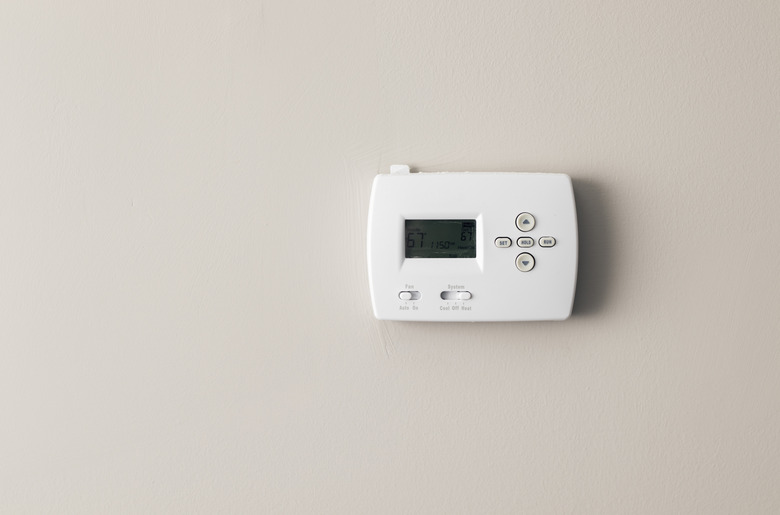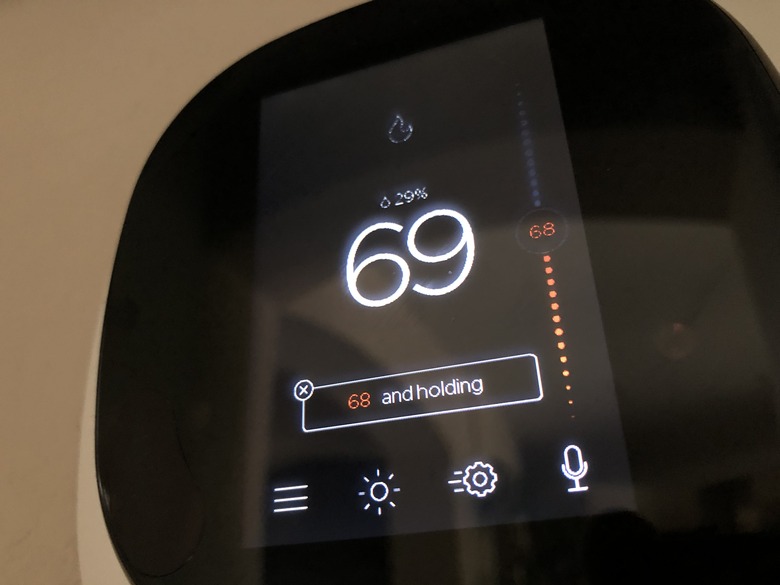Choosing The Right Thermostat For Your Home — Everything You Should Know
We may receive a commission on purchases made from links.
Maintaining your HVAC system by cleaning it, regularly replacing the air filter and scheduling regular tune-ups will definitely improve its energy efficiency, but your overall energy savings will be negligible if you don't have the right thermostat (and if it isn't in the right place). Of all the types of thermostats available today, a smart thermostat is the one most often recommended by HVAC pros, and it can save you as much as $100 on your yearly energy bill. Even a standard programmable thermostat is a step up from a mechanical one, which is basically just an on/off switch for your furnace or air conditioner.
Smart thermostats become more responsive and easier to program with each new model release, and the best ones earn the ENERGY STAR rating, which is reserved for only the most energy-efficient appliances. Before purchasing a thermostat, it's important to evaluate your home heating and cooling system as well as your personal habits and preferences because you may not need or want all that functionality. If you're a hands-on homeowner who doesn't like the idea of communicating with your thermostat through your laptop or phone, you may prefer a standard programmable thermostat or even a mechanical model.
Installation of a new thermostat is usually easy enough for homeowners to do themselves provided that the thermostat is the right type for the system. When replacing an existing thermostat, you can often take a picture of the wires on the old thermostat before disconnecting it and use that as a reference for wiring the new one. The most serious consequence of miswiring a thermostat is usually that it won't work. It's unlikely to cause any damage to the HVAC system, and in most cases, you're working with low voltage, so you won't get a serious shock if you forget to turn off the power.
The Three Types of Thermostats
The Three Types of Thermostats
Electromechanical manual thermostats were the only ones available in the early to mid 20th century and are still used today to control a single-function heating or cooling system. They are basically electrical on/off switches triggered by a temperature-sensitive mechanical sensor — usually a bimetallic strip or a bimetal coil — and they can operate on low voltage (24-volt) from a transformer or from standard voltage (120- or 240-volt) directly from a household circuit. The latter, which are known as line-voltage thermostats, are commonly employed to control an electrical baseboard heating system.
Advances in computer technology in the latter part of the 20th century led to digital thermostats that measure temperature electronically, usually by means of a temperature-sensitive resistor called a thermistor, and they use electronic switches instead of physical ones. A digital programmable thermostat is more responsive to ambient conditions, and in terms of energy efficiency, they are an improvement over a mechanical nonprogrammable thermostat. As designs have become more sophisticated, LED touchscreens are starting to replace physical control buttons, which is either a blessing or a curse depending on your facility with touchscreen technology and your access to the owners' manual.
In the internet age as more and more technology is wired into the cloud, smart thermostats are almost inevitable, giving homeowners the ability to control their home's environment from their favorite mobile device. A smart thermostat offers more than Wi-Fi connectivity, however. Some models, such as the Nest, feature AI technology that can learn from your habits and work in conjunction with Amazon Alexa to automatically create the environment you prefer while operating your home's HVAC system at optimum efficiency and minimizing your energy bills.
The Right Thermostat for Your System
The Right Thermostat for Your System
Before you choose a thermostat, it's important to understand how your thermostat works together with your HVAC system because not all thermostats have the same compatibility. A single-function mechanical thermostat, for example, might be all you need if you only have a furnace, but it isn't compatible with an air system that includes both heating and cooling functions. Some considerations include:
- Heating and cooling: If your system has an outdoor compressor, you either have a heat pump or a combination furnace and air conditioner. The thermostat needs to have terminals to control each function separately, usually labeled W (white) for heat and Y (yellow) for cooling.
- Heat pump: A heat pump can function as either a heater or an air conditioner. To switch between these functions, the thermostat must have B (dark blue) and O (orange) terminals.
- Two-stage heating and cooling: Many air systems feature two-stage heating and cooling as a way of reducing energy use. The thermostat to control these functions must have W2 and Y2 terminals.
- Auxiliary or emergency heating: A thermostat that controls auxiliary heating needs an X/AUX terminal, and one that controls an emergency heat function needs an E terminal.
- Common wire: Many thermostats, including most smart thermostats, need a power source other than the one that controls the HVAC system to operate their various functions. This is supplied through the common wire, or C wire, which is either black or blue. If your new thermostat requires a common wire and your old one didn't, you either have to install that wire or choose a different thermostat. Ecobee and Honeywell Home offer smart thermostats with a power adapter that allows you to connect the C wire to a standard power receptacle.
Some modern HVAC systems feature variable-speed motors, and they usually require specialty thermostats that should be professionally installed. Another consideration is the voltage at which the system operates. The most common is 24 volts, but some systems operate on millivolts, so if you don't know, have your system inspected by a pro before purchasing a thermostat. If you're controlling a baseboard heating system, you'll probably need a line-voltage thermostat.
Do You Need All the Bells and Whistles?
Do You Need All the Bells and Whistles?
The right thermostat for your home may not be the most sophisticated one. Some models, such as the Ecobee 3, tie seamlessly into your home's smart system and can be operated by your wireless device and even your voice, but these cost more than a basic Honeywell programmable model, some of which are also Wi-Fi capable. Top-of-the-line smart thermostats often contain features you may not want or need, such as voice activation.
One such feature found on top-of-the-line smart thermostats is called geofencing, which is the ability to detect a smartphone and operate only when the phone is within range. This feature can lower your energy bills by running the system only when someone is home, but it has drawbacks, not the least of which is that everyone in the home has to have a smartphone to operate the HVAC system.
Another problem is that it requires users to manually operate the thermostat through their phones, and you can't set different temperatures for different times of the day as you can with a standard programmable thermostat. On the other hand, geofencing could be a benefit if you live alone or with a partner, and neither one of you is home very often.
Some smart thermostat features you may or may not want to have include:
- Learning: Once the thermostat learns your habits, it automatically keeps the climate in your house exactly the way you like it. The Nest thermostat is one of the pioneers of this technology.
- Auto changeover: This feature automatically switches the system from heating to cooling so you don't have to remember to do it manually.
- Wi-Fi compatible: Most smart thermostats feature Wi-Fi connectivity, which allows you to program the temperature from the office or from the comfort of your bed.
- Virtual-assistant compatible: Some people are in love with their virtual assistants, while others shun them. Your choice depends on your side of the fence.
- Filter change reminder: People who have a hard time remembering to change the air filter will appreciate this automatic reminder built into some smart thermostats.
References
- Consumer Reports: Thermostat Buying Guide
- PickHvac: In-Depth Thermostat Wiring Guide for Homeowners 2021
- George Brazil Air Conditioning and Heating: A Homeowner's Guide to Choosing a Replacement Thermostat
- General Heating & Air Conditioning: Should You Get a Thermostat With Geofencing Technology?
- ENERGY STAR: ENERGY STAR Ends the Thermostat Wars by Introducing First-Ever Smart Thermostat Specification


